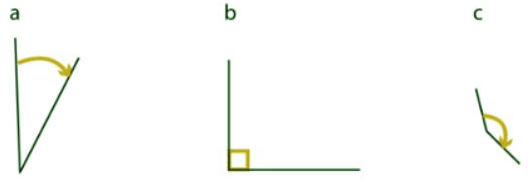Year 5 Exam > Year 5 Notes > Year 5 Mathematics > Compare and order angles
Compare and order angles | Year 5 Mathematics PDF Download
Identifying angles
- An angle measures the size of a turn.
- A right angle is 90° or a quarter turn.
- An acute angle is less than 90°.
- An obtuse angle is greater than 90°.

Examples
Example: 1
Can you identify which of these is the smallest and largest angle? Sol:
Sol:
- Angle a is the smallest angle and is less than a right angle.
- Angle c is the smallest image but is in fact the largest turn. It is the obtuse angle, so it's greater than a right angle.
Example: 2
Can you identify which of the below angles are acute, right angle or obtuse? Sol:
Sol:
- Angle a is 70° so it is acute.
- Angles b and c are both right angles.
- Angles d and e are obtuse as they are 120° and 150°.
- Angle f is acute as it is 25°, so less than 90°.
The document Compare and order angles | Year 5 Mathematics is a part of the Year 5 Course Year 5 Mathematics.
All you need of Year 5 at this link: Year 5
|
45 videos|51 docs|15 tests
|
FAQs on Compare and order angles - Year 5 Mathematics
| 1. What are the different types of angles? |  |
Ans. The different types of angles are acute angles, right angles, obtuse angles, straight angles, and reflex angles.
| 2. How do you measure angles? |  |
Ans. Angles are measured in degrees using a protractor. The protractor is placed at the vertex of the angle, and the measurement is read where the second side of the angle intersects the protractor.
| 3. How do you classify angles based on their measurements? |  |
Ans. Angles can be classified as acute angles (less than 90 degrees), right angles (exactly 90 degrees), obtuse angles (greater than 90 degrees but less than 180 degrees), and reflex angles (greater than 180 degrees).
| 4. How can I determine if two angles are complementary or supplementary? |  |
Ans. Two angles are complementary if the sum of their measures is 90 degrees and supplementary if the sum of their measures is 180 degrees. To determine this, add the measures of the angles together and check if they equal 90 degrees for complementary angles or 180 degrees for supplementary angles.
| 5. Can angles be classified based on their relationships with other angles? |  |
Ans. Yes, angles can be classified based on their relationships with other angles, such as vertical angles, adjacent angles, corresponding angles, alternate interior angles, and alternate exterior angles. These relationships help in solving angle-related problems more easily.
Related Searches




















